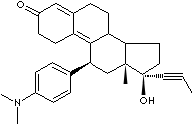| CAS
NO |
84371-65-3;
83203-42-3; 122742-25-0 |

|
| EINECS
NO. |
|
| FORMULA |
C29H35NO2 |
| MOL
WT. |
429.60 |
|
H.S.
CODE
|
|
|
TOXICITY
|
|
| SYNONYMS |
RU-486;
|
| 11beta-[4-(Dimethylamino)phenyl]-17beta-hydroxy-17-(1-propynyl)estra-4,9-dien-3-one;
|
| SMILES |
|
|
CLASSIFICATION
|
|
|
PHYSICAL
AND CHEMICAL PROPERTIES
|
| PHYSICAL
STATE |
yellowish crystalline
powder |
| MELTING
POINT |
192
- 195 C |
| BOILING
POINT |
|
| SPECIFIC
GRAVITY |
|
| SOLUBILITY
IN WATER |
|
| pH |
|
| VAPOR
DENSITY |
|
|
REFRACTIVE
INDEX
|
|
|
NFPA
RATINGS
|
|
|
AUTOIGNITION
|
|
| FLASH
POINT |
|
| STABILITY |
Stable
under ordinary conditions. |
|
APPLICATIONS
|
| Mifepristone, a substituted 19-nor steroid compound, is a substance of progesterone
receptor antagonist. It induces abortion in
the first trimester by inhibiting the formation of progestational agents. The
chemical designation is
11beta-[4-(Dimethylamino) phenyl]- 17beta-hydroxy-17-(1- propynyl)estra- 4,9-dien-3-one.
It is a yellowish powder; poorly soluble in water, soluble in methanol, chloroform and acetone.
|
| SALES
SPECIFICATION |
|
APPEARANCE
|
yellowish crystalline
powder |
|
IDENTIFICATION
|
Complies
|
|
ASSAY
|
98.5%
min
|
|
OPTICAL
ROTATION
|
+124°
~ +129°
|
|
LOSS
ON DRYING
|
0.5%
max
|
|
STEROID
IMPURITY
|
2.0%
max (Individual impurity: 0.5% max)
|
| TRANSPORTATION |
| PACKING |
|
| HAZARD
CLASS |
|
| UN
NO. |
|
| OTHER
INFORMATION |
|
Hazard Symbols: T, Risk Phrases: 60-61,
Safety Phrases: 53-22-36/37/39-45 |
|
GENERAL
DESCRIPTION OF PROGESTERONE |
|
Progesterone is a female sex hormone that plays an important physiological role
to regularize and rebuild changes to the body caused by estrogen as well as in
the luteal phase of the menstrual cycle. Its levels vary during the menstrual
cycle. If fertilization occurs, it is produced during pregnancy by the placenta
to prevent spontaneous abortion. If fertilization does not take place, the
production of progesterone decreases and menstruation occurs. It is the hormone
for the mammary glands of milk production. Progesterone is a steroid hormone
consists chemically of four fused hydrocarbons containing the functional groups
of ketone and aldehyde and two methyl branches. Progesterone is the precursor
of all steroid hormones. It is used as an intermediate in
the biosynthesis of androgens, estrogens, and the corticoids. Synthetic
compounds with progesterone are used in the prevention of miscarriage, in the
treatment of menstrual disorders. It is also used to develop a constituent of
some oral contraceptives. Progesterone
Receptor Agonists
- Medroxyprogesterone
- Norethynodrel
- Progesterone
Progesterone
Receptor Antagonists
Androgen
Receptor Agonists
- Androstenedione
- Fluoxymesterone
- Methyltrienolone
- Oxandrolone
- Oxymetholone
- Stanolone
- Testosterone
Androgen
Receptor Antagonists
- Bicalutamide
- 2-Hydroxyflutamide
- Nilutamide
- Cyproterone
Estrogen
Receptor Agonists
- 17-beta-Estradiol
- Estrone
- Moxestrol
Estrogen
Receptor Antagonists
- 4-Hydroxytamoxifen
- Keoxifene
|
